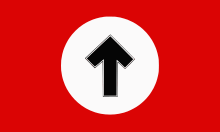
The Homeland, previously known as the National Democratic Party of Germany, is a far-right Neo-Nazi and ultranationalist political party in Germany.

Strasserism is an ideological strand of Nazism which adheres to revolutionary nationalism and to economic antisemitism, which conditions are to be achieved with radical, mass-action and worker-based politics that are more aggressive than the politics of the Hitlerite leaders of the Nazi Party. Named after Gregor Strasser and Otto Strasser, the ideology of Strasserism is a type of Third Position, right-wing politics in opposition to Communism and to Hitlerite Nazism.
Column 88 was a neo-Nazi paramilitary organisation based in the United Kingdom. It was formed in the early 1970s, and disbanded in the early 1980s. The members of Column 88 undertook military training under the supervision of a former Royal Marine Commando, and also held regular gatherings attended by neo-nazis from all over Europe. The name is code: the eighth letter of the alphabet 'HH' represents the Nazi greeting 'Heil Hitler'. Journalist Martin Walker described Column 88 as a "shadow paramilitary Nazi group".
The Flag Group was a British far-right political party, formed from one of the two wings of the National Front in the 1980s. Formed in opposition to the Political Soldier wing of the Official National Front, it took its name from The Flag, a newspaper the followers of this faction formed after leaving and regrouping outside the main and diminishing rump of the rest of the party.
The Third Position is a set of neo-fascist political ideologies that were first described in Western Europe following the Second World War. Developed in the context of the Cold War, it developed its name through the claim that it represented a third position between the capitalism of the Western Bloc and the communism of the Eastern Bloc.

The Deutsche Reichspartei (DRP), also known as the German Empire Party or German Imperial Party, was a nationalist, far-right, and later neo-Nazi political party in West Germany. It was founded in 1950 from the German Right Party, which had been set up in Lower Saxony in 1946 and had five members in the first Bundestag, and from which it took the name. Its biggest success and only major breakthrough came in the 1959 Rhineland-Palatinate regional election, when it sent a deputy to the assembly.

Giorgio Almirante was an Italian politician who founded the neo-fascist Italian Social Movement, which he led until his retirement in 1987.

Michael Kühnen was a leader in the German neo-Nazi movement. He was one of the first post-World War II Germans to openly embrace Nazism and call for the formation of a Fourth Reich. He enacted a policy of setting up several differently named groups in an effort to confuse German authorities, who were attempting to shut down neo-Nazi groups. Kühnen's homosexuality was made public in 1986, and he died of HIV-related complications in 1991.

Christian Worch is a prominent German neo-Nazi activist and chairman of the far-right political party Die Rechte.

The Action Front of National Socialists/National Activists was a West German neo-Nazi organization founded in 1977 by Michael Kühnen under the name "Action Front of National Socialists" (ANS). It was based around a group of young neo-Nazis in Hamburg. Upon founding the group Kühnen declared "we are a revolutionary party dedicated to restoring the values of the Third Reich" and adopted a version of the Nazi flag in which the swastika was reversed, with the spaces black and the actual cross blending into the background, as their organization's emblem. He sought to link his movement with other groups, by seeking links with Waffen-SS veterans organisations, sending a delegation to the Order of Flemish Militants-organised international neo-Nazi rallies in Diksmuide and working closely with the Wiking-Jugend.

CEDADE was a Spanish neo-Nazi group that concerned itself with co-ordinating international activity and publishing.
The German Right Party was a far-right political party that emerged in the British zone of Allied-occupied Germany after the Second World War.
The Nationalist Front was a minor German neo-Nazi group active during the 1980s.

Friedhelm Busse was a German neo-Nazi politician and activist. In a career taking in some six decades Busse established himself as a leading voice of German neo-Nazism.
The German Alternative was a minor neo-nazi group set up in Germany by Michael Kühnen in 1989.
The National Offensive was a German neo-Nazi party, which existed from 3 July 1990 to 22 December 1992.

The Volkssozialistische Bewegung Deutschlands/Partei der Arbeit (VSBD/PdA) or People's Socialist Movement of Germany/Labour Party was a German neo-Nazi organization led by Friedhelm Busse.
Graham Keith Williamson is a long-time political activist in the United Kingdom, having been active at the top levels of various far right groups including the National Front, the Third Way and Solidarity.

The German Party was a national-conservative political party in West Germany active during the post-war years. The party's ideology appealed to sentiments of German nationalism and nostalgia for the German Empire.












